Archive for August, 2012
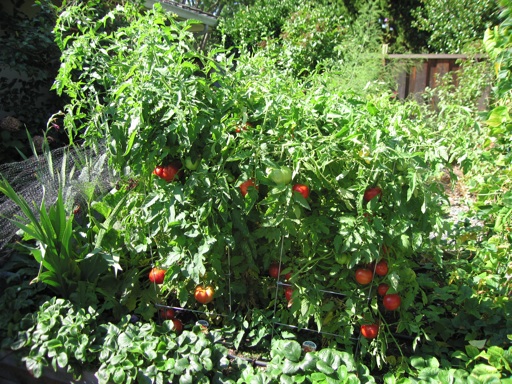
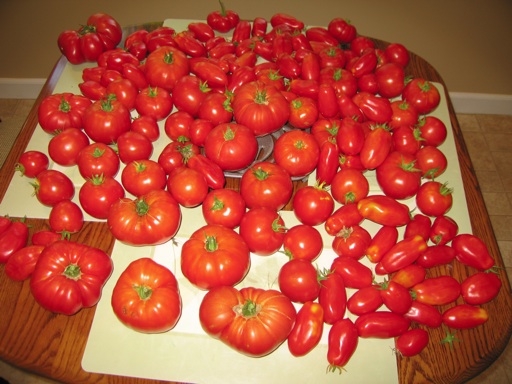
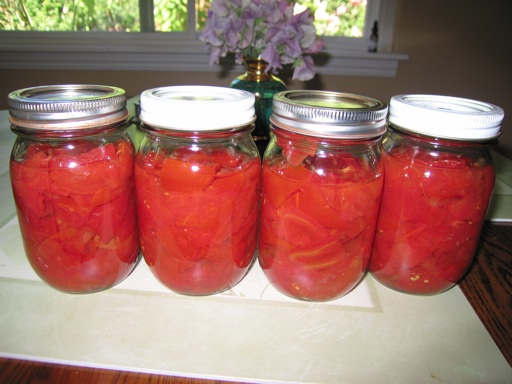
This year, I planted only four tomato plants. The varieties I selected were Big Beef, Beefsteak, Beefmaster, and San Marzano (a plum tomato). I planted nursery transplants in mid-March to give them a head start on the growing season. They grew quickly even in our mild early spring weather, when the highs were only in the 60s. By mid-July, they had ripe tomatoes.
Our Beefmaster tomato plant started to die before it produced many tomatoes. But our other three tomato plants have produced hundreds of tomatoes. Two weeks ago, I harvested all the tomatoes shown on the table in the above picture. We couldn’t possibly eat all of these tomatoes before they went bad, so I canned most them.
The San Marzano tomatoes are ideal for canning. The other varieties are often eaten fresh, but I decided to can all four varieties. I just canned them as plain tomato slices, which is a lot less work than making a tomato sauce first and then canning the sauce like I did in previous years.
I began by slicing each tomato into sections small enough to fit into the jars. Then, I removed the tomato seeds using my fingers, although I wasn’t able to remove them all. That part alone was at least 90 minutes of work for 2 people. I didn’t bother to remove the tomato skins. Removing the skins requires an additional step that is a lot of extra work for so many tomatoes. I don’t mind tomato skins in my food. I usually end up pureeing the canned tomatoes before I use them in a recipe anyway. But I don’t like lots of seeds floating around in the jars.
After cooking the sliced and de-seeded tomatoes in boiling water for 5 minutes using a hot pack method, I packed each jar with tomatoes and some lemon juice for extra acidity leaving about 1 inch of space from the top. Then I processed the jars in a pressure cooker canner at 10 psi for about 25 minutes. I filled about 18 jars with about 3/4 of the tomatoes. (if you use a pressure cooker, be sure to follow the product directions of use carefully). Tomatoes canned this way can be stored for up to a year at room temperature. I used this same technique last summer to can tomato slices. We used our canned tomatoes for more than 6 months before we ran out of them.
August 25 2012 | Tomatoes | Comments Off on Canning Tomatoes
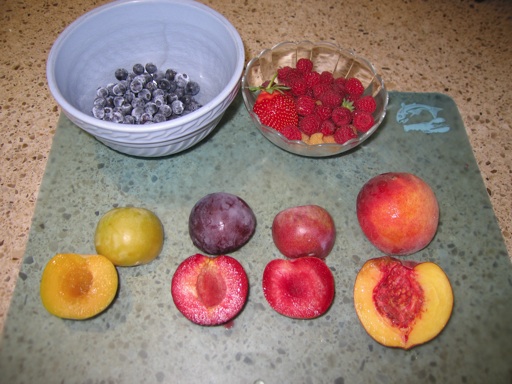
Today, I harvested and ate our first flavor queen pluot. It’s the greenish fruit on the left in the above picture. It had a very mild, somewhat sweet, flavor with no tartness. I thought it tasted nothing like a plum. I have read that flavor queen can be extremely sweet, but our weather has been so mild lately (highs in the mid-70s) that it may not have been able to reach its full sweetness potential.
I have now tasted all four of the pluot varieties from our multi-grafted pluot tree, flavor king, flavor queen, flavor supreme, and dapple dandy. I like all 4 varieties. Each one is different in color and taste. The dark purple fruit in the above picture is a flavor king. It has a nice plum-like flavor. It tastes better than most plums, except maybe Laroda plum. The skin is just a bit tart, no where near as tart as Santa Rosa or Beauty plum.
The pink fruit in the above picture is a dapple dandy pluot. The dapple dandy scion of our very small multi-grafted tree has produced at least 3 dozen pluots this year, many more than the other 3 scions. The fruits have been hanging on the tree in a near ripened state for a few weeks. The first dapple dandies I picked last month were tart. But now they are sweet with very little tartness. Like flavor queen, they taste nothing like plums, but they are sweeter than flavor queen (at least ours are). Dapple dandy may be my favorite pluot of our 4 varieties, because of the combination of producing lots of fruits and its nice mild fruity flavor.
The flavor supremes ripened over a month ago, which is why I wasn’t able to put one in this picture. They also have a delicious flavor that is somewhat plum-like.
The fruit in the lower right of the picture is one of our first O’Henry peaches of the season. Our O’Henry peach tree is now 10 years old, and I have eaten a lot of them over the years. The weather has a big effect on the flavor of our peaches too. Our O’Henry peaches so far haven’t been very sweet. They’re not too tart, just kind of bland. Again, I blame it on the mild weather. It takes some heat (80+) for several days to get them sweet. Last year, the first 2/3 of our peaches were plain tasting. But in the last week of August, we had several days of warm weather (mid-80s-about 90) and the peaches that ripened after that warm spell were sweet and very tasty.
The blueberries, raspberries and strawberry in the bowls are also from our garden. There’s not many strawberries or blueberries left to harvest, but our red and yellow everbearing raspberries are just starting to produce a lot of berries.
August 17 2012 | Peaches/Nectarines and Pluots | Comments Off on Fruity Flavors
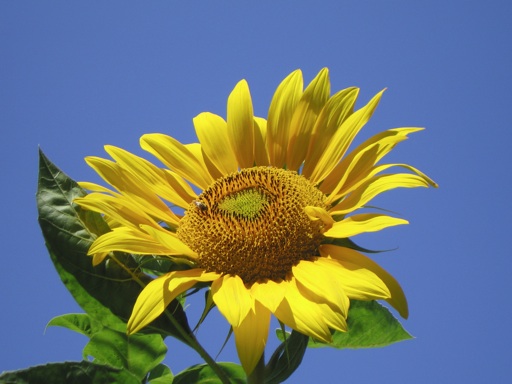
I planted seeds from a variety of sunflowers called Mammoth Grey Stripe in late May of this year. Some of them have grown as tall as about 10 feet. They just started blooming about a week ago. This is the first time I have grown sunflowers in many years. I’m not sure if I am going to bother to harvest and utilize the seeds, but sunflowers really do make an impressive display in a vegetable garden for a few weeks.
August 13 2012 | Sunflowers | Comments Off on Sunflowers
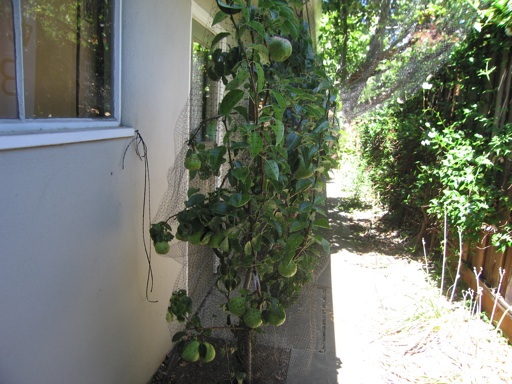
When I first moved into the house I live in, there was a small tree growing near the side door of the garage, crammed into a 2-foot strip between the house and a concrete pathway. The tree produced large fuzzy yellow fruits in the fall that resembled apples. I eventually discovered that the fuzzy yellow fruits were quinces. It turns out quinces are so sour they can’t be eaten fresh. They are mainly used to make jams and jellies.
In any event, I noticed some scrawny branches were growing from the bottom of the tree that had different looking leaves than the quince. I was able to identify those branches as pear branches, because there are two other pear trees on the property that had the same type of leaves. After doing some research, I figured out that the previous owners of the property had intended to plant a third pear tree, not a quince. It turns out that pear scions are often grafted onto quince rootstocks. However, rootstocks often grow suckers. If the suckers are not cut back, they can grow into a tree and eventually kill the scion.
After deciding we’d rather have another pear tree than a quince tree, we cut back the quince sucker to near where the pear scion was grafted onto it. That was about 3 or 4 years ago. Since then, the pear scion has grown considerably and produced pears. It bloomed during the quince years, but it never set any fruit. This year, it has produced about 20 pears (see above picture), which is impressive for such a small tree. The quince was a vigorous grower, so I think the tree developed a substantial root system prior to when we finally cut back the quince sucker.
A few years ago, I realized that this pear tree was producing two different looking types of pears. One type of pear was thinner in shape and ripened in August. It looked and tasted like a Bartlett pear. The other type of pear was fatter in shape, had a different color skin, and ripened much later. It looked and tasted like a Comice pear. So it turns out this tree is a multi-grafted pear tree. It was an interesting choice, because the two other pear trees on the property that were planted by the previous owners are a Bartlett and a Comice. Somebody really liked pears, which is fine with me because I really like them too. Most of the pears in this picture are Bartlett pears.
August 10 2012 | Pears | Comments Off on Multi-grafted Pear Tree
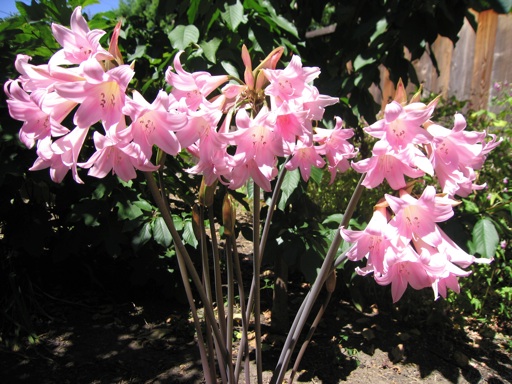
Our amaryllis belladonna is in bloom again. It has at least a dozen stems of very fragrant flowers this year. After the leaves died down, the flower stems appeared from the dry bare earth and opened up into clusters of flowers in only about 2 weeks in late July.
Amaryllis belladonna requires almost no care in our climate. I never water or fertilize it. They live off wintertime rains. I only need to clean up the dead leaves in June and the dead flower stems in September.
I think I planted only one amaryllis belladonna bulb about 10 years ago in this spot, but it has multiplied into several bulbs over the years. It took years to come into flower, but now it flowers reliably every summer. I see amaryllis belladonna flowers all around the Bay Area. They often grow in untended dry areas, such as in strips between the sidewalk and the street.
August 10 2012 | Amaryllis | Comments Off on Amaryllis Belladonna
Next »






